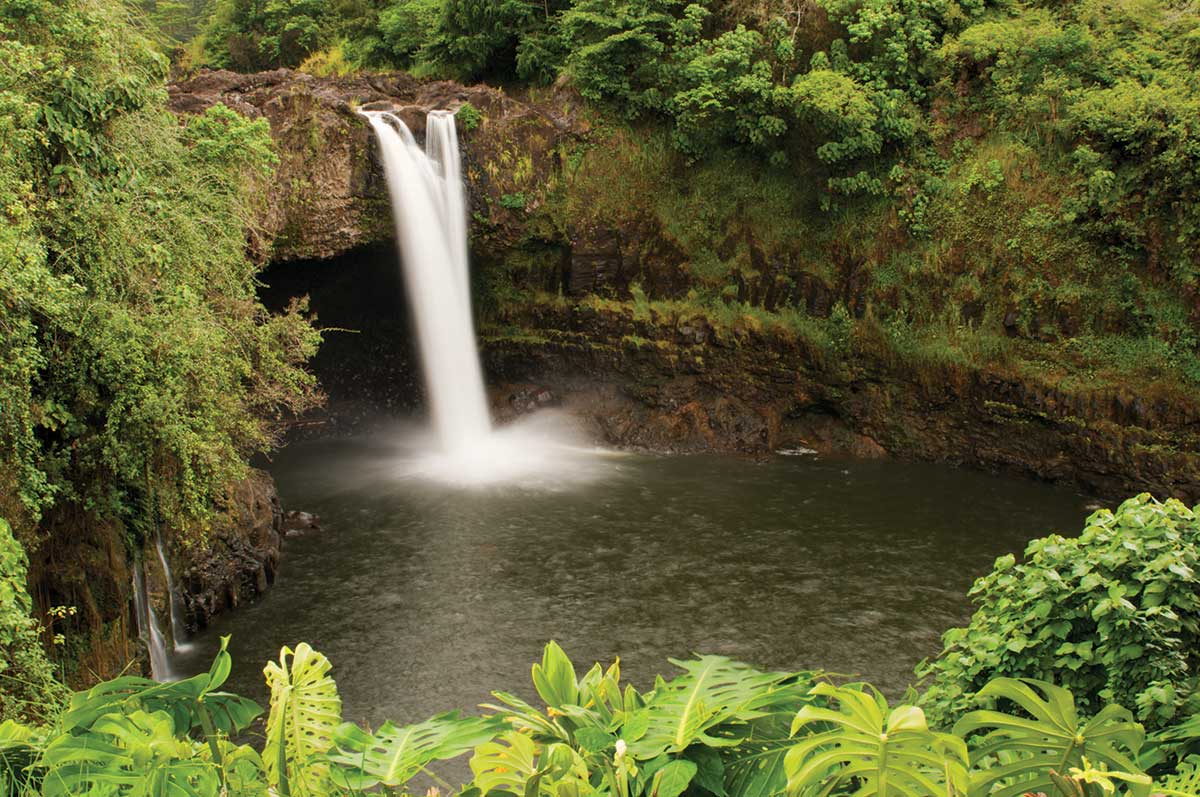Tom Bentley for the Mercury News on Big Island waterfalls. Our Wild & Scenic Volcano Tour will bring you to the famous Rainbow Falls in comfort and luxury.
HILO, Hawaiʻi — The sights and sounds of falling water trip the senses. The noise alone — the gushing, the rolling, the crashing, the sprinkling — is a delightful earful. Then the visuals: the sprays of light, the mesmerizing movements, the intricate folding of layered waters. Enfold that intensity in the exuberant greenery on Hawaiʻi’s Big Island, and you have an electricity of feeling that seems to bypass the brain.
I felt dumbstruck enough simply to be able to go anywhere with my sweetheart Alice after a year-and-a-half travel drought. To spend eight summer days based in Hilo, where the rains fell drenchingly, daily, sometimes for hours, seemed almost hallucinatory. (That the day after we left, the island’s drier Kona side suffered its biggest fire in history brought a slap of California-style reality to my hallucination.)
But back to those waters: The Big Island has a startling number of climate zones. Hilo and coastal points north are in the “Tropical Continuously Wet” category. What do you get when you combine bunches of rain and hilly terrain? Waterfalls, lots of them. Heck, you barely have to bump out of Hilo proper to get a good gander at some.
Just a couple of miles drive from downtown takes you to Rainbow Falls, where you can park and be gaping in moments. The Wailuku River generously feeds the 80-foot falls, which plunge over a yawning lava-cave mouth. The walkway that goes above the falls was closed, but you can still admire the stout trees studded with ferns and other blossoming growths on the green grounds.
A jaunt further upriver gives you easy access to Pe’epe’e Falls (pronounced Peh-eh Peh-eh Falls, for all of you experiencing the need to express your sixth-grade boy). Several fellow falls gush over a rocky cliff into the hustling Wailuku waters below. And those below waters flash in and out of a series of river-carved bowls dubbed Boiling Pots, which if not boiling were at least frothing merrily at our visit.
Further upriver, but still close and easily accessed, the river surges over the stacked natural terraces at Wai’ale Falls, the Wailuku seemingly propelled with even more power — the pounding sound of the water a sonorous sizzling song.
Seeing those clustered falls was almost too easy, but getting out on the road a bit north of Hilo on Highway 19, the Belt Road on the Hamakua Coast, to see more falling waters isn’t effortful either. And the scenery and greenery will overwhelm your eyes. Past mile marker 7 is a turn for the old highway — take it! There are stretches of remarkable foliage and growth that made me think of remote jungles: mad vines twisting up tall trees, leaves like giant paddles, heavy air, a damp screaming of green — wow!
For more frosting on nature’s cake, head for the Hawaiʻi Tropical Bioreserve and Garden off the old highway, a dizzying wonderland of manic and subtle growth. There were so many bold, dramatic orchids growing along the walkways, they seem to almost have been glued there for spectacle. Since we’re talking waterfalls, make sure to visit the sinuous and snaky Onomea Falls within the garden, and the quieter but moody Boulder Creek falls as well.
After you get back on the Belt Road, take the ’Akaka Falls turnoff to go inland for a few miles. It’s worth it: ’Akaka is a 400-foot-plus beauty, even if the parking lot was a madhouse when we arrived. The falls were draped in a dancing mist and there were lots of mingling folks, but both the main falls and the side falls along the walkways were a spectacle.
Then continue on past mile marker 16 and pull over after the bridge there. There are a couple of waterfalls on the inland side that are gorgeous. Let’s call them Bridge Falls, because I couldn’t find a name.
We didn’t venture further, although many more falls await, as does the legendarily lovely Waipi’o Valley. We were too hungry for lunch at one of Hilo’s many great restaurants, both upscale and casual. We could have explored falling waters in other parts of this expansive island, but then we would have missed a couple of days in the Kilauea volcano zones, driving up Mauna Kea (until the car sharply insisted we go down), snorkeling in agreeable waters and simply sighing about all things Hawaiʻi.
Scary stuff is happening with climate change on the whole globe, and Hawaiʻi isn’t being spared. But we felt grateful to see the poetry of its falling waters, and hope for more visits to come.





